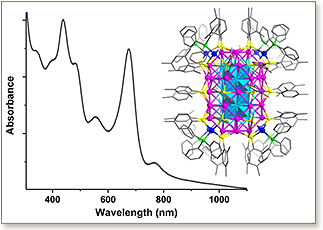

 Engineering the surface ligands of metal nanoparticles is critical in designing unique arrangements of metal atoms. Here, we report the synthesis and total structure determination of a large box-shaped Ag67 nanocluster (NC) protected by a mixed shell of thiolate (2,4-dimethylbenzenethiolate, SPhMe2) and phosphine (triphenylphosphine, PPh3) ligands. Single crystal X-ray diffraction (SCXRD) and electrospray ionization mass spectrometry (ESI-MS) revealed the cluster formula to be [Ag67(SPhMe2)32(PPh3)8]3+. The crystal structure shows an Ag23 metal core covered by a layer of Ag44S32P8 arranged in the shape of a box. The Ag23 core was formed through an unprecedented centered cuboctahedron, i.e., Ag13, unlike the common centered Ag13 icosahedron geometry. Two types of ligand motifs, eight AgS3P and eight bridging thiols, were found to stabilize the whole cluster. The optical spectrum of this NC displayed highly structured multiple absorption peaks. The electronic structure and optical spectrum of Ag67 were computed using time-dependent density functional theory (TDDFT) for both the full cluster [Ag67(SPhMe2)32(PPh3)8]3+ and a reduced model [Ag67(SH)32(PH3)8]3+. The lowest metal-to-metal transitions in the range 500–800 nm could be explained by considering the reduced model that shows almost identical electronic states to 32 free electrons in a jellium box. The successful synthesis of the large box-shaped Ag67 NC facilitated by the combined use of phosphine and thiol paves the way for synthesizing other metal clusters with unprecedented shapes by judicious choice of thiols and phosphines.
Engineering the surface ligands of metal nanoparticles is critical in designing unique arrangements of metal atoms. Here, we report the synthesis and total structure determination of a large box-shaped Ag67 nanocluster (NC) protected by a mixed shell of thiolate (2,4-dimethylbenzenethiolate, SPhMe2) and phosphine (triphenylphosphine, PPh3) ligands. Single crystal X-ray diffraction (SCXRD) and electrospray ionization mass spectrometry (ESI-MS) revealed the cluster formula to be [Ag67(SPhMe2)32(PPh3)8]3+. The crystal structure shows an Ag23 metal core covered by a layer of Ag44S32P8 arranged in the shape of a box. The Ag23 core was formed through an unprecedented centered cuboctahedron, i.e., Ag13, unlike the common centered Ag13 icosahedron geometry. Two types of ligand motifs, eight AgS3P and eight bridging thiols, were found to stabilize the whole cluster. The optical spectrum of this NC displayed highly structured multiple absorption peaks. The electronic structure and optical spectrum of Ag67 were computed using time-dependent density functional theory (TDDFT) for both the full cluster [Ag67(SPhMe2)32(PPh3)8]3+ and a reduced model [Ag67(SH)32(PH3)8]3+. The lowest metal-to-metal transitions in the range 500–800 nm could be explained by considering the reduced model that shows almost identical electronic states to 32 free electrons in a jellium box. The successful synthesis of the large box-shaped Ag67 NC facilitated by the combined use of phosphine and thiol paves the way for synthesizing other metal clusters with unprecedented shapes by judicious choice of thiols and phosphines.